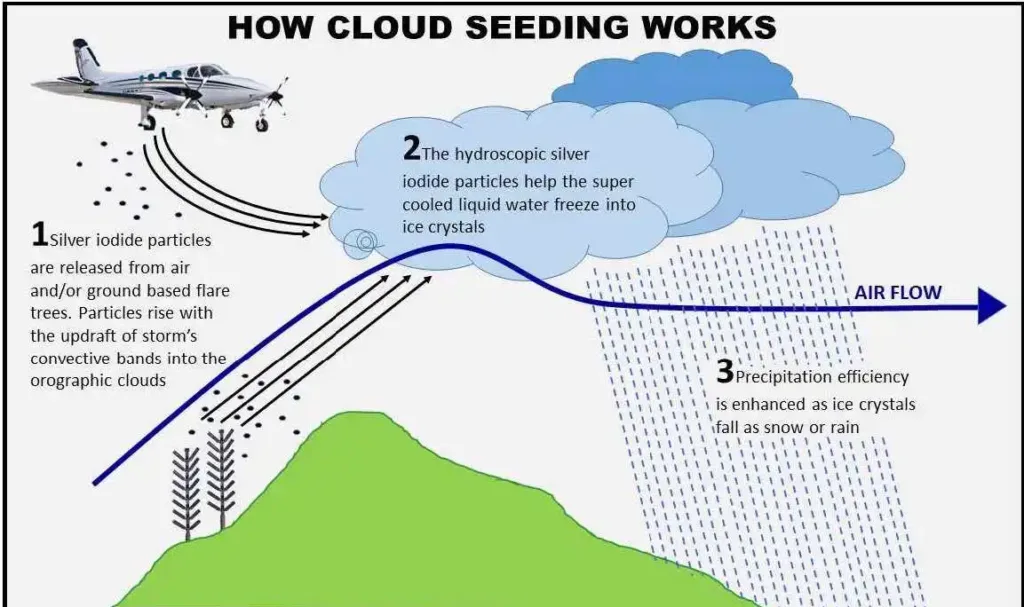Artificial Rain also termed as cloud seeding involves a process to stimulate clouds to enhance precipitation. While it’s a complex process typically that carried out by professionals. Basic principle of cloud seeding revolves around introducing certain substances into clouds to encourage the formation and growth of raindrops.
Understanding Cloud Seeding:
Cloud seeding aims to alter the microphysical processes within clouds to increase rainfall. The most common method involves using substance like silver iodide, potassium iodide or sodium chloride as seeding agents. These substances act as nuclei around which water droplets can condense ultimately forming larger droplets that can fall as artificial rain.

The Artificial Rain Process:
- Identifying Suitable Clouds: Cloud seeding requires the right kind of clouds. Cumulus and cumulonimbus clouds are often targeted as they possess the necessary vertical development and moisture content suitable for seeding.
- Choosing the Method: There are various methods to disperse seeding agents including Aircraft, rockets or ground-based generators. Aircraft release the seeding agents into the clouds while ground-based methods use flares or burners to disperse the substances.
- Seeding Agents: Silver iodide is one of the most commonly used substances as seeding agent. It has a similar crystal structure to ice. When released into the cloud, it provides a surface for ice crystals to form which enhance the process of formation of raindrops.
- Stimulating Condensation: The seeding agent encourages the formation of ice crystals or water droplets in the cloud. These particles grow in size and eventually fall as precipitation.
Limitations and Controversies:
Cloud seeding is not a guaranteed method to produce artificial rain. Its success heavily depends on the natural atmospheric conditions such as the presence of clouds with sufficient moisture content and updrafts to support the growth of seeded particles. There are ongoing debates about the effectiveness and environmental impacts of cloud seeding. Critics argue that altering natural weather patterns could have unforeseen consequences. However, researchers believe that it can be a valuable tool specially in regions facing water scarcity, droughts or during periods of low rainfall.
Ethical and Environmental Considerations:
While cloud seeding has shown promising results in artificial raining, its ethical implications and potential environmental impacts warrant careful consideration. Altering precipitation patterns can affect ecosystems, water resources and agricultural practices. Regulatory bodies and international agreements often oversee cloud seeding activities to ensure they comply with ethical and environmental standards. Transparency, scientific research and collaboration among meteorologists, environmentalists and policymakers are crucial in determining the responsible use of this technology.
Cloud seeding Benefits
Despite being a debated and somewhat controversial practice, cloud seeding is considered beneficial for artificial rain in certain circumstances for several reasons:
Addressing Water Scarcity: In regions facing water scarcity or drought, cloud seeding is explored as a method to augment precipitation. By enhancing rainfall this process aims to supplement natural water resources particularly for agricultural and domestic purposes.
Agricultural Benefits: Increased rainfall can benefit agriculture by ensuring adequate water supply for crops. In regions heavily reliant on rainfall for farming, cloud seeding might offer a potential solution during dry spells.
Water Resource Management: Cloud seeding can be seen as a part of water resource management strategies. It’s explored in reservoir catchment areas to increase water levels and improve the supply for cities and industries.
Mitigate Air Pollution: Cloud seeding is a potential source in mitigating smog by promoting artificial rain that cleanses the atmosphere of pollutants. Encouraging precipitation through seeding can help clear the stagnant air and reduce the concentration of harmful particles aiding in smog dispersal.
Fight Natural Disasters: In some cases, cloud seeding is studied as a means to mitigate extreme weather events such as hailstorms. By disrupting the growth of hailstones or redirecting their paths, it’s considered to minimise the damage that could be caused by hail.
Research and Development: Cloud seeding serves as an ongoing area of research to understand atmospheric processes better. Studying its effectiveness and limitations contributes to a deeper comprehension of weather patterns and precipitation mechanisms.
Conclusion:
Artificial rain making through cloud seeding remains a field of ongoing research and debate. While it holds promise as a potential tool to address multiple water scarcity and pollution related issues. it’s essential to approach it cautiously, considering its limitations, potential impacts and ethical considerations. Collaborative efforts, scientific advancements and responsible practices can pave the way for harnessing this technology to mitigate water scarcity, mitigate air pollution and benefit communities in need all while preserving the delicate balance of nature.
For more related news Click Here.

